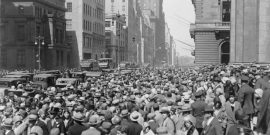Sometimes it fails, but it's remarkable how often it works.
Fairy Lights in the Big City
Like a drunken but unforgettable one-night stand between Jay McInerny’s Bright Lights, Big City, and Neil Gaiman’s Neverwhere, Tara Isabella Burton’s Here In Avalon rips up the map of genre fiction, breaking walls and blurring boundaries that normally keep romance, thriller, fantasy, and literary fiction safely separated. The result is a bittersweet, romantic ride, but also a work that inspires us to think more deeply about the very nature of the genres we enjoy, to question, in effect, the genre of our own dreams and desires, and the writerly magic inherent in all fiction.
All writers are tricksters.
That’s partly because all writing is world-building and the written world’s resemblance to the “real“ world is irrelevant: whether the story takes place a long time ago in a galaxy far, far away, or right this minute in the grittiest back alley of a known and named city, the author must still artfully deploy an array of signs and symbols and gestures to induce us, the readers, to imagine and vicariously experience that world.
But sometimes, like a skilled stage magician, the writer lets us in or grants the illusion they are letting us in on these tricks while holding us pleasurably in that uncertainty, in the very act of questioning what is or isn’t real or possible. These kinds of works set both their characters and their readers on a quest for the holy grail, the answer to the questions: what in the end is this life, and is another better life possible?
Tara Isabella Burton is precisely that kind of magician. Her new novel, Here in Avalon is at once a romantic thriller and an urban fairy tale, a bitter piece of hate mail directed at the finance-fueled loss of New York’s soul and a poignant love letter to its bohemian remnants. It is a bildungsroman disguised as a mystery, devoted to the perils and pleasures of the quest for a better life.
At the heart of Burton’s novel are two sisters, Rose and Cecilia. Rose, despite or because of a childhood at the chaotic margins of old bohemian New York, has gone for the good life—working at a start-up, living with a Tech CEO. Meanwhile, her sister Cecilia’s life has been one failed, quixotic quest for love and meaning after another. The real fuse is lit early when Cecilia goes missing. But has she been kidnapped or seduced by a cult—or has she literally gone off with the fairies?
In a quite marvelous essay about writing her novel, Burton admits she tried for many drafts to make this a pure literary thriller, but it only gelled when she, in effect, “let the fairies in.“ I for one am grateful she did.
Burton’s novel juxtaposes the real city of New York and another place name—Avalon, the mythic, misty island where Excalibur was forged and the mortally wounded Arthur was brought to heal and await his second coming.
Burton’s previous non-fiction books have explored the culture of the self and of self-creation from the Renaissance to the selfie, and the vast and often bizarre range of, as she puts it, “new religions“ in a “Godless world.“ Both works combined deep philosophical, historical, sociological, psychological, and even theological knowledge with compelling journalistic reportage and deeply personal, even confessional, reflection. Both Self-Made and Strange Rites displayed an acute sensitivity to the various ways that disenchanted humanity—adrift in a potentially senseless, materialist world without gods or monsters (other than the human variety)—exercise our inbuilt drive for transcendence and meaning. Here in Avalon draws deeply from the experiences and insights gained and shared in both of her non-fiction books but the origins of her latest novel, by her own admission, lie especially in Strange Rites and in particular its opening sections. Burton was impacted by her experiences of fandom and cult hood in the performance/party world in New York, especially the literally and metaphorically intoxicating world that grew around the Punchdrunk Theater’s interactive Macbeth experience, Sleep No More in the 2010s.
One of the more popular subgenres of genre fiction these last few decades is known as Urban Fantasy. Fantasy as a genre is not normally at home in the city. It is traditionally built on the wider literary topos of Arcadia—the green world—think Shakespeare’s various magical woods. But in our metageneric days, when so much of our popular fiction mixes or “mashes“ genres, a name was apparently needed for tales that specifically play the keynotes and chords of fantasy but on a distinctly urban keyboard. In truth, this is not a new genre at all. At least since Dickens found London to be as mysterious and magical a place as the Baghdad of the 1001 Nights and the mid-nineteenth century vogue for Mysteries of the City like Eugène Sue’s Mysteries of Paris and George W. M. Reynolds’s Mysteries of London, the city has been seen as both an engine of disenchantment and at the same time a secretly enchanted place. In fact, the genres of mystery and thriller fiction rely on this trope—the city as a dangerous and enticing place of magic and mystery.
Burton’s novel juxtaposes the real city of New York and another place, Avalon—the mythic, misty island where Excalibur was forged and the mortally wounded Arthur was brought to heal and await his second coming. The name Avalon has come to stand not only for the entirety of the Arthurian mythos, but for the very locus of all fantasy. And in this literal tension between the real place, New York, and an imagined place, Avalon, lies the powerful charm of this book.
The great Franco-Bulgarian literary theorist, Tzvetan Todorov, quite precisely defined this tension and named it “The Fantastic“:
The fantastic … lasts only as long as a certain hesitation: a hesitation common to reader and character, who must decide whether or not what they perceive derives from “reality“ as it exists in the common opinion. …The fantastic is that hesitation experienced by a person who knows only the laws of nature, confronting an apparently supernatural event. … Once we choose one answer or the other, we leave the fantastic for a neighboring genre.
Note the way Todorov says “neighboring genre,“ as if genres weren’t so much types as places, zones, geographies. And indeed they are—Westerns, Crime novels, Country House Mysteries, Regency Romances, and Space Operas are just a few of the genres defined almost inevitably by the kinds of places they take place. Here in Avalon runs wild across more than a few of these different genre neighborhoods, like an intoxicant-fueled all-night run from one end of Manhattan to the other.
In the end, Tara Isabella Burton’s novel isn’t so much Urban Fantasy as what Todorov might have called the Urban Fantastic. And nearly all the way to its final pages, Burton keeps us thrillingly uncertain as to where the exact boundaries of the real and the supernatural lie. There is much more in this lush novel than just the question of “is or isn’t there magic.“ Whatever the final answer and wherever this tale lies on the map of genre neighborhoods, Burton’s novel is itself a darkly magical place filled with the kind of writerly magic that can keep even sleepy fingers turning the pages of Here in Avalon late into the night.


